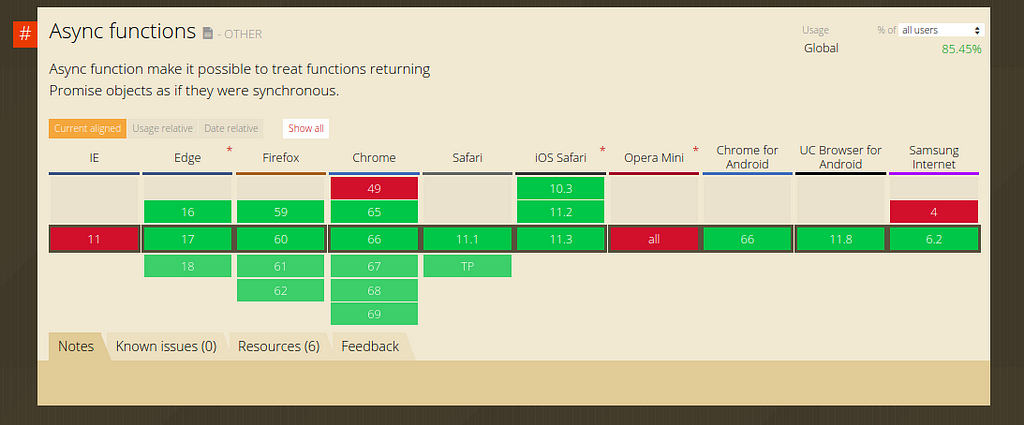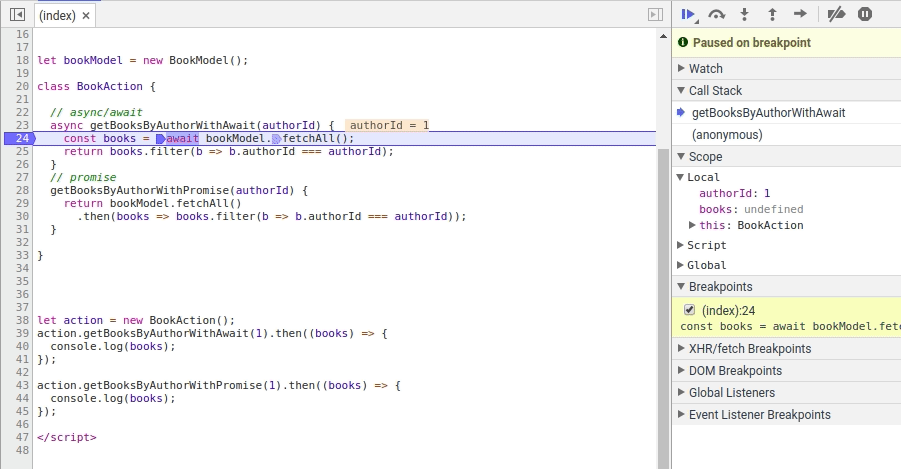Latest news about Bitcoin and all cryptocurrencies. Your daily crypto news habit.

The async/await introduced by ES7 is a fantastic improvement in asynchronous programming with JavaScript. It provided an option of using synchronous style code to access resoruces asynchronously, without blocking the main thread. However it is a bit tricky to use it well. In this article we will explore async/await from different perspectives, and will show how to use them correctly and effectively.
The good part in async/await
The most important benefit async/await brought to us is the synchronous programming style. Let’s see an example.
// async/awaitasync getBooksByAuthorWithAwait(authorId) { const books = await bookModel.fetchAll(); return books.filter(b => b.authorId === authorId);}// promisegetBooksByAuthorWithPromise(authorId) { return bookModel.fetchAll() .then(books => books.filter(b => b.authorId === authorId));}It is obvious that the async/awaitversion is way easier understanding than the promise version. If you ignore the await keyword, the code just looks like any other synchronous languages such as Python.
And the sweet spot is not only readability. async/await has native browser support. As of today, all the mainstream browsers have full support to async functions.
 All mainstream browsers support Async functions. (Source: https://caniuse.com/)
All mainstream browsers support Async functions. (Source: https://caniuse.com/)
Native support means you don’t have to transpile the code. More importantly, it facilitates debugging. When you set a breakpoint at the function entry point and step over the await line, you will see the debugger halt for a short while while bookModel.fetchAll() doing its job, then it moves to the next .filter line! This is much easier than the promise case, in which you have to setup another breakpoint on the .filter line.
 Debugging async function. Debugger will wait at the await line and move to the next on resolved.
Debugging async function. Debugger will wait at the await line and move to the next on resolved.
Another less obvious benefit is the async keyword. It declares that the getBooksByAuthorWithAwait() function return value is guaranteed to be a promise, so that callers can call getBooksByAuthorWithAwait().then(...) or await getBooksByAuthorWithAwait() safely. Think about this case (bad practice!):
getBooksByAuthorWithPromise(authorId) { if (!authorId) { return null; } return bookModel.fetchAll() .then(books => books.filter(b => b.authorId === authorId)); }}In above code, getBooksByAuthorWithPromise may return a promise (normal case) or a null value (exceptional case), in which case caller cannot call .then() safely. With async declaration, it becomes impossible for this kind of code.
Async/await Could Be Misleading
Some articles compare async/await with Promise and claim it is the next generation in the evolution of JavaScript asynchronous programming, which I respectfully disagree. Async/await IS an improvement, but it is no more than a syntactic sugar, which will not change our programming style completely.
Essentially, async functions are still promises. You have to understand promises before you can use async functions correctly, and even worse, most of the time you need to use promises along with async functions.
Consider the getBooksByAuthorWithAwait() and getBooksByAuthorWithPromises() functions in above example. Note that they are not only identical functionally, they also have exactly the same interface!
This means getBooksByAuthorWithAwait() will return a promise if you call it directly.
Well, this is not necessarily a bad thing. Only the name await gives people a feeling that “Oh great this can convert asynchronous functions to synchronous functions” which is actually wrong.
Async/await Pitfalls
So what mistakes may be made when using async/await? Here are some common ones.
Too Sequential
Although await can make your code look like synchronous, keep in mind that they are still asynchronous and care must be taken to avoid being too sequential.
async getBooksAndAuthor(authorId) { const books = await bookModel.fetchAll(); const author = await authorModel.fetch(authorId); return { author, books: books.filter(book => book.authorId === authorId), };}This code looks logically correct. However this is wrong.
- await bookModel.fetchAll() will wait until fetchAll() returns.
- Then await authorModel.fetch(authorId) will be called.
Notice that authorModel.fetch(authorId) does not depend on the result of bookModel.fetchAll() and in fact they can be called in parallel! However by using await here these two calls become sequential and the total execution time will be much longer than the parallel version.
Here is the correct way:
async getBooksAndAuthor(authorId) { const bookPromise = bookModel.fetchAll(); const authorPromise = authorModel.fetch(authorId); const book = await bookPromise; const author = await authorPromise; return { author, books: books.filter(book => book.authorId === authorId), };}Or even worse, if you want to fetch a list of items one by one, you have to rely on promises:
async getAuthors(authorIds) { // WRONG, this will cause sequential calls // const authors = _.map( // authorIds, // id => await authorModel.fetch(id));// CORRECT const promises = _.map(authorIds, id => authorModel.fetch(id)); const authors = await Promise.all(promises);}
In short, you still need to think about the workflows asynchronously, then try to write code synchronously with await. In complicated workflow it might be easier to use promises directly.
Error Handling
With promises, an async function have two possible return values: resolved value, and rejected value. And we can use .then() for normal case and .catch() for exceptional case. However with async/await error handling could be tricky.
try…catch
The most standard (and my recommended) way is to use try...catch statement. When await a call, any rejected value will be thrown as an exception. Here is an example:
class BookModel { fetchAll() { return new Promise((resolve, reject) => { window.setTimeout(() => { reject({'error': 400}) }, 1000); }); }}// async/awaitasync getBooksByAuthorWithAwait(authorId) {try { const books = await bookModel.fetchAll();} catch (error) { console.log(error); // { "error": 400 }}The catched error is exactly the rejected value. After we caught the exception, we have several ways to deal with it:
- Handle the exception, and return a normal value. (Not using any return statement in the catch block is equivalent to using return undefined; and is a normal value as well.)
- Throw it, if you want the caller to handle it. You can either throw the plain error object directly like throw error;, which allows you to use this async getBooksByAuthorWithAwait() function in a promise chain (i.e. you can still call it like getBooksByAuthorWithAwait().then(...).catch(error => ...)); Or you can wrap the error with Error object, like throw new Error(error) , which will give the full stack trace when this error is displayed in the console.
- Reject it, like return Promise.reject(error) . This is equivalent to throw error so it is not recommended.
The benefits of using try...catch are:
- Simple, traditional. As long as you have experience of other languages such as Java or C++, you won’t have any difficulty understanding this.
- You can still wrap multiple await calls in a single try...catch block to handle errors in one place, if per-step error handling is not necessary.
There is also one flaw in this approach. Since try...catch will catch every exception in the block, some other exceptions which not usually caught by promises will be caught. Think about this example:
class BookModel { fetchAll() { cb(); // note `cb` is undefined and will result an exception return fetch('/books'); }}try { bookModel.fetchAll();} catch(error) { console.log(error); // This will print "cb is not defined"}Run this code an you will get an error ReferenceError: cb is not defined in the console, in black color. The error was output by console.log() but not the JavaScript itself. Sometimes this could be fatal: If BookModel is enclosed deeply in a series of function calls and one of the call swallows the error, then it will be extremely hard to find an undefined error like this.
Making functions return both value
Another way for error handling is inspired by Go language. It allows async function to return both the error and the result. See this blog post for the detail:
How to write async await without try-catch blocks in Javascript
In short, you can use async function like this:
[err, user] = await to(UserModel.findById(1));
Personally I don’t like this approach since it brings Go style into JavaScript which feels unnatural, but in some cases this might be quite useful.
Using .catch
The final approach we will introduce here is to continue using .catch().
Recall the functionality of await: It will wait for a promise to complete its job. Also please recall that promise.catch() will return a promise too! So we can write error handling like this:
// books === undefined if error happens,// since nothing returned in the catch statementlet books = await bookModel.fetchAll() .catch((error) => { console.log(error); });There are two minor issues in this approach:
- It is a mixture of promises and async functions. You still need to understand how promises work to read it.
- Error handling comes before normal path, which is not intuitive.
Conclusion
The async/await keywords introduced by ES7 is definitely an improvement to JavaScript asynchronous programming. It can make code easier to read and debug. However in order to use them correctly, one must completely understand promises, since they are no more than syntactic sugar, and the underlying technique is still promises.
Hope this post can give you some ideas about async/await themselves, and can help you prevent some common mistakes. Thanks for your reading, and please clap for me if you like this post.
JavaScript async/await: The Good Part, Pitfalls and How to Use was originally published in Hacker Noon on Medium, where people are continuing the conversation by highlighting and responding to this story.
Disclaimer
The views and opinions expressed in this article are solely those of the authors and do not reflect the views of Bitcoin Insider. Every investment and trading move involves risk - this is especially true for cryptocurrencies given their volatility. We strongly advise our readers to conduct their own research when making a decision.